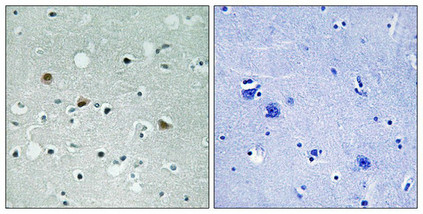
Immunohistochemical analysis of paraffin-embedded human brain tissue using LATS1/2 (Phospho-Thr1079/1041) antibody (left)or the same antibody preincubated with blocking peptide (right).
Phospho-LATS1/LATS2 (Thr1079/1041) Antibody
CSB-PA905508
ApplicationsELISA, ImmunoHistoChemistry
Product group Antibodies
ReactivityHuman, Mouse
TargetLATS1
Overview
- SupplierCusabio
- Product NamePhospho-LATS1/LATS2 (Thr1079/1041) Antibody
- Delivery Days Customer20
- ApplicationsELISA, ImmunoHistoChemistry
- CertificationResearch Use Only
- ClonalityPolyclonal
- ConjugateUnconjugated
- Gene ID9113
- Target nameLATS1
- Target descriptionlarge tumor suppressor kinase 1
- Target synonymsh-warts; large tumor suppressor homolog 1; LATS (large tumor suppressor, Drosophila) homolog 1; LATS, large tumor suppressor, homolog 1; serine/threonine-protein kinase LATS1; WARTS; WARTS protein kinase; wts
- HostRabbit
- IsotypeIgG
- Protein IDO95835
- Protein NameSerine/threonine-protein kinase LATS1
- Scientific DescriptionThe protein encoded by this gene is a putative serine/threonine kinase that localizes to the mitotic apparatus and complexes with cell cycle controller CDC2 kinase in early mitosis. The protein is phosphorylated in a cell-cycle dependent manner, with late prophase phosphorylation remaining through metaphase. The N-terminal region of the protein binds CDC2 to form a complex showing reduced H1 histone kinase activity, indicating a role as a negative regulator of CDC2/cyclin A. In addition, the C-terminal kinase domain binds to its own N-terminal region, suggesting potential negative regulation through interference with complex formation via intramolecular binding. Tao W., Nat. Genet. 21:177-181(1999). Nishiyama Y., FEBS Lett. 459:159-165(1999). The MGC Project Team, Genome Res. 14:2121-2127(2004).
- ReactivityHuman, Mouse
- Storage Instruction-20°C or -80°C
- UNSPSC12352203
